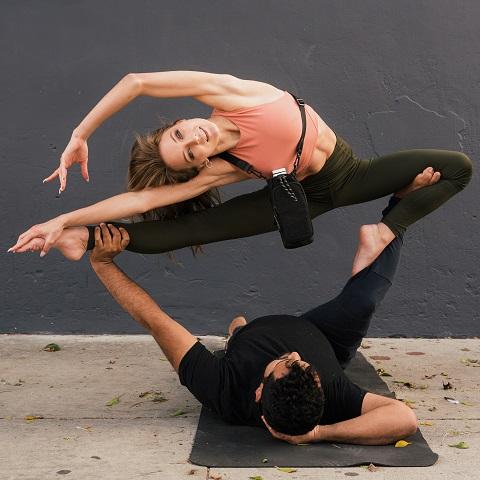Yoga, a spiritual discipline that focuses on breath control, mental meditation, and body poses, has gained increasing popularity in Western culture, providing a respite for those who wish to disconnect from the world and reconnect with their minds and bodies.
In addition to fostering mindfulness and managing stress, yoga also provides numerous unsung mental and physical benefits both on and off the mat that can improve your overall sense of full-body well-being. Motivation for practicing yoga can be as simple as wanting to master the proper stretches to do before working out. However, motivation can also stem from the desire to reduce stress, increase relaxation, cultivate compassionate self-awareness, and much more. Read on for an exploration into the benefits of yoga that aren’t readily available at your mudra-positioned fingertips.

1. Fights Cravings and Improves Digestion
Always feel like a chocolate fudge sundae is calling your name? Or are you constantly feeling bloated after a meal?
Yoga may also help quell unhealthy cravings and jumpstart your metabolism.
Many yoga poses focus on your core, where the majority of your digestive system is located. As such, yoga stimulates your abdominal muscles, increasing blood circulation and muscle stimulation that revs up your metabolism, aiding weight loss and an overall sense of well-being.
In addition, a study by the Journal of the American Dietetic Association found that yoga can contribute to mindful eating. Because the practice increases your mind-body awareness, yoga may make you more sensitive to feelings of fullness, reducing urges to overeat or snack on an unhealthy treat.1 Yoga can also reduce feelings of stress, which may aid those who tend to grab a bag of chips when feeling anxious or overwhelmed.
There are also various yoga poses that regulate the release of hormones that affect your appetite, including:
- Waterfall pose – Practitioners lie on their back with their legs straight in the air, fully opening the chest, supporting the lower back, and releasing the excitatory state produced by cravings.
- Child pose – With your knees and forehead touching the ground, the forward bend increases the flow of energy throughout the body and reduces feelings of stress, which can contribute to overeating.
- Bridge pose – With the feet planted firmly on the ground with the back arched, this backbend can redirect attention from cravings to the fingers and toes.
-
Tree pose – In a standing position for this yoga pose, one leg is firmly planted on the ground, while the other sits on your opposite thigh. The tree posture improves concentration, redirecting the mind to focus on balance rather than scrumptious donuts and salty chips.
2. Improves Brain Function
Are you struggling with staying on-task throughout the day or suffering from major writer’s block? Yoga may help.
The effects of yoga are similar to those of aerobic exercise—it can improve cognitive function, attention, and memory, which may increase your creativity and productivity throughout the day through concentrated repetition.
In fact, a study published by the Brain Plasticity journal found that those who regularly practiced Hatha yoga and Kundalini yoga exhibited greater cortical thickness in their brains—indicating general intelligence.2 Yoga classes may also have a positive effect on areas of the brain that are responsible for memory, information processing, and emotional regulation.
How exactly does yoga improve emotional regulation?
It’s known to increase the mood of those who practice it, which can improve your brain’s overall health and functioning, including behavioral and emotional responses.3
For yoga poses that increase your mental functioning and concentration, we’ve got you covered:
- Lotus pose – Sit upright with your legs crossed, with both feet resting on the opposite thigh and your arms resting on your knees to promote a sense of calm and improve brain function. Don’t forget to breathe deeply.
- Shoulder stand pose – Lie on your back, then, keeping your legs together and hands at your sides, slowly raise your legs until they’re at a 90-degree angle to your body. Place your palms on your lower back and lift your waist up so that your legs and body are straightly aligned. This move engages your entire body to improve your focus and concentration.
- Standing forward bend pose – Stand up straight and slowly lower your upper body from your hips so that your hands are touching the ground or hanging in front of you. This position stimulates the nervous system, promoting blood flow to the brain to improve your memory.
3. Supports a Good Night’s Sleep
Yoga is gentle, slow-moving, and restorative. As such, regular practice is known to reduce stress within the body and support healthy sleep cycles.
A key component in the yoga-sleep synergy is mindful breathing exercises. Specifically, Ujjayi Breath (also known as Ocean Breath or Victorious Breath) soothes your body’s systems through a deep breathing technique that involves inhaling and exhaling through the nose while constricting the back of your throat as if you’re making a “ha” sound.4
Additionally, practicing yoga poses before bedtime can relieve tension and stress throughout the body to promote a restful night’s sleep:
- Wide-knee child’s pose – With your knees and forehead to the floor and your arms stretched behind you, relaxing into this pose helps release tension in your body, especially when taking slow and steady breaths.
- Standing half forward bend – With your feet planted firmly on the floor, bend your upper body to a 90-degree angle and stretch your arms in front of you for full-body relaxation.
- Reclining bound angle – Lie down on the ground and bring the soles of your feet together so that your legs create a diamond shape. Relax your arms to the side of your body and breathe in deeply to calm the mind and stretch the hip muscles.
- Corpse pose – Lie your back on the ground with your legs and arms stretched out in a relaxed position to calm the central nervous system and lower blood pressure.

4. Boosts Immunity and Decreases Inflammation
Regular yoga practice, breathing, and medication can rid the body of toxins and rebalance your body’s systems—including your immune system. This benefit is amplified during the practice of hot yoga, so your body can also reap the benefits of sweating.
More specifically, yoga may help reduce inflammation. Inflammation is a normal immune response in which the body becomes swollen and inflamed as a reaction to an injury or an infection.
Several studies suggest that yoga can slow the harmful effects of inflammation and oxidative stress (the imbalance of the production and accumulation of oxygen in the tissues of your body, which can negatively affect the structure and function of your body’s cells).5
A study conducted by William Bushell, Ph.D. of the Massachusetts Institute of Technology found that the anti-stress and anti-inflammatory properties of yoga can increase your vagal tone, a biological process that activates the nervous system to increase feelings of relaxation after a stress response.6
In order to reduce stress and boost immunity, restorative postures and revitalizing breathing meditations can significantly protect and bolster your immune system:
- Plank pose – Align your hands directly under your shoulders and come into a plank position to strengthen the core and boost immunity.
- Downward-facing dog pose – With your hands and arms planted firmly into the ground, lift your pelvis into the air to create an “A” shape with your body to stimulate blood flow.
- Wide-legged standing forward bend – Stand firmly on the ground, interlace your hands behind you, and bend your hips downward to increase blood circulation to your head.
5. Improves your Listening Skills
According to a study conducted by the Aura Wellness Center, children who practice yoga have seen improvements in their concentration, focus, and listening skills.7 It’s safe to assume the same could be true for adults.
During a yoga practice, practitioners must listen carefully to oral cues from the yoga instructor regarding body poses, breath counts, and transitions from one position to another. As the saying goes, practice makes perfect. The repeated practice of intently listening to verbal cues ensures that the poses are being performed correctly—and hones your auditory perception too.
Similarly, yoga can also help practitioners listen to their bodies.
Yoga encourages mindful movements and attentiveness to pay attention to what your body is trying to tell you—whether your body is craving a delicious veggie-packed salad or asking to rest to avoid any injury from overstretching.
The BEIS Line for Yoga
Practicing just 20 minutes of yoga a day can improve your overall health and wellness—not only through mindfulness and relaxation, but through improved listening skills, digestion, brain function, sleep, and immunity, too.
As you know, the baseline of yoga is breathing, meditation, and poses, but there’s also a BEIS line for yoga.
BEIS has you covered.
Sources:
- Men’s Journal. 7 Things You Didn’t Know Yoga Could Do for Your Body. https://www.mensjournal.com/health-fitness/7-things-you-didnt-know-yoga-could-do-your-body/3-improves-brain-function/
- IOS Press Content Library. Yoga Effects on Brain Health. https://content.iospress.com/articles/brain-plasticity/bpl190084
- CNBC. Doing yoga just once or twice a week can boost brain performance. https://www.cnbc.com/2019/12/17/study-practicing-yoga-improves-brain-health-and-emotional-functioning.htm
- Harvard Health Publishing. Yoga for Better Sleep. https://www.health.harvard.edu/blog/8753-201512048753
- Harvard Health Publishing. Yoga could slow the harmful effects of stress and inflammation. https://www.health.harvard.edu/blog/yoga-could-slow-the-harmful-effects-of-stress-and-inflammation-2017101912588
- Yoga Journal. Want to Strengthen Your Immune System? Science Says Do More Yoga. https://www.yogajournal.com/yoga-101/strength-your-immune-system-with-yoga/
- Aura Wellness Center. Can Kids Yoga Improve Listening Skills? https://www.aurawellnesscenter.com/2012/04/23/can-kids-yoga-improve-listening-skills/






